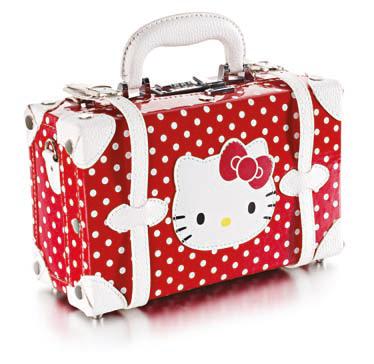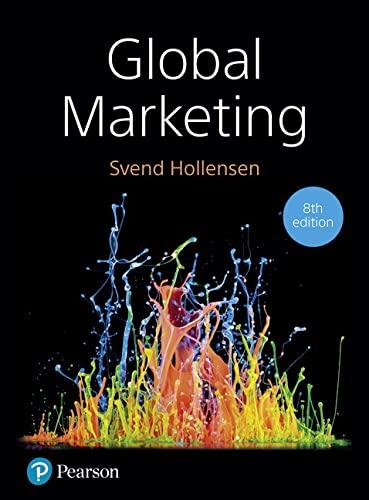When, in 1974, employees at the Japanese design company Sanrio created Hello Kitty (www.sanrio. com/characters/HelloKitty/), the small,
Question:
When, in 1974, employees at the Japanese design company Sanrio created Hello Kitty (www.sanrio.
com/characters/HelloKitty/), the small, rounded cartoon cat with a red bow between her ears and no mouth, they had no idea she would become the global megastar she is today. The face of Hello Kitty adorns 50,000 products, sold in more than 130 countries. Saniro conducts its business operations through 26 subsidiaries. It has operations in Japan, the US, the UK, Brazil, Germany, Taiwan, South Korea, Hong Kong and China.
History
Hello Kitty was created with the focus of being a small gift, whatever the product is. The unique selling proposition (USP) has always been ‘small gift, big smile’.
Hello Kitty’s creator, Sanrio, was founded by Shintaro Tsuji in 1960; Tsuji, a qualified chemist, lost his mother when he was 13 and spent an unhappy childhood with reluctant relatives. He attended a kindergarten run by a Canadian missionary and saw for the first time the custom of birthdays, which were not traditionally celebrated in Japan. He decided he would use his company to foster the culture of gift-giving.
The little half-Japanese, half-English cat has become so globally recognizable that it is, perhaps, inevitable that the Japanese board of tourism has appointed her as their official tourism ambassador to China and Hong Kong. This is not the first time the world has looked to Hello Kitty to perform an

ambassadorial role; she was US children’s ambassador for UNICEF in 1983.
Hello Kitty was first drawn in 1974. She was drawn without a mouth, which later made her the perfect cross-cultural representative. She wasn’t given a mouth, because she speaks from the heart. She’s Sanrio’s ambassador to the world and isn’t bound to any particular language.
Hello Kitty was made partly English because, when she was first drawn, foreign (especially English) associations were particularly popular. The Hello Kitty stationery (pencils, pencil cases, ballpoints pens, paper) and diaries were a hit among schoolgirls during the 1980s and the company soon branched out into other fancy goods.
In the 1990s, Hello Kitty had a renaissance. Shops, run by the outlet label Vivitix, marketed Hello Kitty to teens and adults, appealing to their sense of nostalgia.
As eight-year-olds they would have used Hello Kitty pencils and pencil cases in the classroom;
in their late teens and early 20s, they reached for Hello Kitty satchels and make-up mirrors. Hello Kitty stands for the innocence and sincerity of childhood and the simplicity of the world. Women and girls all over the world are happy to buy in to the image of the trusting, loving childhood in a safe neighbourhood that Hello Kitty represents. They don’t want to let go of that image, so as they grow up, they hang on to Hello Kitty out of nostalgia – as if by keeping a symbolic object, they can somehow keep hold of a fragment of their childhood self.
Now, although originally conceived as a character that would appeal to pre-teen girls, Hello Kitty is no longer regarded as being for children only.
Along with the likes of Coca-Cola and Nike, she has become a brand phenomenon.
Hello Kitty is technically just one character who inhabits an entire, fictional world dreamt up by Sanrio.
She lives in cyberspace (on the fondant-coloured Sanriotown website, www.sanrio.com/
characters/HelloKitty/). Hello Kitty has her own birthday, 1 November (which makes her a Scorpio)
and, as her English heritage befits, she lives in London with her parents and twin sister, Mimmy.
Her many hobbies include travelling, music, reading and ‘eating yummy cookies her mother Mary bakes’.
Other characters who share Hello Kitty’s world include Dear Daniel, Kathy, Tippy and Thomas.
Sanrio’s theme park, Puroland, opened in 1990; it features Sanrio’s most popular characters, with Hello Kitty as its star draw, and with annual figures of 1.5 million visitors from around the world, it is one of Japan’s most popular visitor attractions.
Hello Kitty even became an animated character.
She first appeared on the American-animated Hello Kitty’s Furry Tale Theater, which was shown on US television throughout 1987. She also appeared in a puppet animation ‘Kitty and Mummy’s New Umbrella’ in 1981.
When Hello Kitty was first marketed to the US, the cultural differences meant that changes to the Japanese version had to be made. Sanrio’s market research showed that American consumers responded best to pink and purple kitties and worst to anything blue, yellow or red. The American audience also took against one of Hello Kitty’s friends, a little snail, which had to be eliminated from the merchandise.......
Questions
1. Do you think that Hello Kitty will continue to rule the world? What are the pros and cons?
2. What are the reasons that Hello Kitty is licensed to so many different product manufacturers?
3. Suggest a future licensing strategy for Hello Kitty.
Step by Step Answer:






